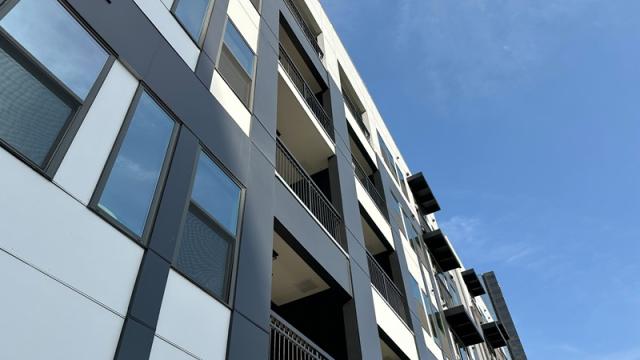webinar

CoStar Group


Apartments.com

Owners, Managers Facing Most Challenging Market Conditions Since 2008-09
Overdevelopment, economic uncertainty, and slowing rent growth contributing factors
The seemingly imminent recession is the next hit to a recent, receding apartment industry’s overall performance.
The declining economy and shrinking rent growth across the country — especially in recent hot markets and for 4- and 5-star communities — were the key topics discussed during Apartments.com’s latest Apartmentology webinar.
It featured commentary and analysis from Christine Cooper, Managing Director and Chief Economist, and Jay Lybik, National Director of Multifamily Analytics, with CoStar Group.
Lybik said in 2023, owners and managers will be challenged with the most difficult market conditions since 2008-09.
He explained that the apartment rent growth situation has shifted dramatically over the past 12 months. After seeing 700,000 units absorbed in 2021, a big pullback occurred in 2022. Absorption fell to just 170,000 apartment homes in 2022, meaning demand was on the decline.
Only 27,000 units were absorbed in Q3 2022, and barely more than 9,000 in Q4.
“This can be traced to economic uncertainty and high inflation, such as in gas prices, which held back household formation,” Lybik said.
“Renting became out of reach for many individuals, as they chose to hold back making major financial decisions.”
Vacancy rates went from 4.9 percent at the end of 2021 to 6.2 today as supply is outpacing demand.
CoStar forecasts vacancy rates to go to 7.2 percent 12 months from now.
Rent growth decelerating faster than anticipated
Troubling for operators is that rent growth is decelerating much faster than anticipated, he said.
Rent growth went from 11 percent a year ago to 3.7 percent. The year-over-year rent growth figures in 2023 should continue to decline in the first half of the year before a slight rebound occurs to finish the year at 2.2 percent, according to Lybik.
Driving rent growth declines are the performance of 4- and 5-star assets, which have moved from 13.6 growth to 2.8 percent, while 3-star communities are holding steady at 4.3 percent year-over-year growth.
Six of the bottom 10 market performers in 2022 were high-fliers coming in: Atlanta, Austin, Salt Lake City, Charlotte, Las Vegas, and Raleigh started the year 2022 as growth leaders.
Lybik emphasized that the current rent growth weakness is not the result of seasonality, weather, or the holidays. It turned negative in August, breaking a 21-month streak of positive results.
“We have now recorded five consecutive months of sequential rent declines,” he said.
Developers ‘overshot’ apartment demand post-2021
Demand skyrocketed in 2021, but developers overshot the mark after that. The current construction pipeline has sat at its highest level since the 1970s. These will be 4- and 5-star apartments, keeping the pressure on that Class level for all of 2023.
It is projected that the 2023 supply will hit the highest total since the mid-1980s at 507,000 units.
Many markets will set records for annual completions, with many in the Sunbelt: Austin, Atlanta, Washington, DC; Charlotte; Denver; Orlando; Miami; Tampa; and Raleigh could experience the most ever witnessed.
None more so than in Austin, which, pre-pandemic, averaged 8,000 per year. But in 2021, it absorbed 20,000, but that fell to 7,000 in 2022. Consider: It has 19,000 units coming online in 2023, on top of the 15,000 that came in 2022.
This year, Austin could deliver more units than Atlanta despite being three times smaller.
In 2023, the rent growth of almost two-thirds of the top 44 markets will be smaller than their five-year, pre-pandemic average. Palm Beach is forecast to be negative, and Phoenix will be zero.
Recession in 2023 is ‘almost certain,’ though inflation and supply chain are stabilizing
Cooper assessed the macroeconomic picture, showing supply chain challenges and decades-high inflation rates are crimping the economy.
“It looks like we’ve seen peak inflation, and the supply chain is easing,” Cooper said. “Transportation costs are coming down. The cost of physical goods has fallen lately.”
CPI peaked at 9.1 in 2022. It has eased but remains elevated; the core CPI, which excludes food and energy, is moving sideways and not falling.
Nonetheless, “We’re almost certain to fall into recession this year, and household spending will drop,” she said.
The services sector has been inspired by the reopening of travel and restaurants but is still high.
Shelter costs are a major factor in the services index, which lags in the index and has yet to stop accelerating.
“It is trending lower, or not moving higher, so it will show some relief in the index in the near future,” Cooper said.
She added that inflation should ease meaningfully but not fall back to pre-pandemic levels.
Until inflation is firmly in a downward trend, the Fed has promised that it will continue to lift rates higher. Cooper estimated that it raised them by 425 bps in 2022; an additional 75bps is expected in the first half of this year.
“The Fed can’t fix supply chain or assist in the war, so it’s squelching the situation as best it can with interest-rate hikes,” Cooper said.
“The labor market remains strong, if not resilient, and household balance sheets are in good shape.”
Employment holding up well
The country created 223,000 jobs in December, exceeding expectations, and the unemployment rate is at 3.5 percent, near historic lows.
First-time and continuing unemployment claims are near pre-pandemic lows.
“Those workers who are laid off are finding new jobs rather easily; there are 10 million job openings, so labor demand definitely remains,” Cooper said.
The days of piling money into technology and innovation that enables more hiring took place during recent years when money was close to free – but those days are gone now, given the Fed’s actions.
Business activity and services activity are falling, a trend that continues into contraction as orders slow.
GDP is expected to contract in 2023 before recovering in 2024. How severe the contraction remains is anyone’s guess. It will hinge on how long employers hold onto their employees.







